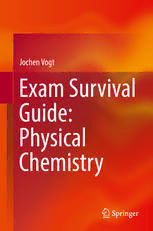
Exam Survival Guide: Physical Chemistry PDF
Preview Exam Survival Guide: Physical Chemistry
Jochen Vogt Exam Survival Guide: Physical Chemistry Exam Survival Guide: Physical Chemistry Jochen Vogt Exam Survival Guide: Physical Chemistry 123 JochenVogt ChemischesInstitut derUniversitaRtMagdeburg Magdeburg,Germany ISBN978-3-319-49808-9 ISBN978-3-319-49810-2 (eBook) DOI10.1007/978-3-319-49810-2 LibraryofCongressControlNumber:2017933473 ©SpringerInternationalPublishingAG2017 Thisworkissubjecttocopyright.AllrightsarereservedbythePublisher,whetherthewholeorpartof thematerialisconcerned,specificallytherightsoftranslation,reprinting,reuseofillustrations,recitation, broadcasting,reproductiononmicrofilmsorinanyotherphysicalway,andtransmissionorinformation storageandretrieval,electronicadaptation,computersoftware,orbysimilarordissimilarmethodology nowknownorhereafterdeveloped. Theuseofgeneraldescriptivenames,registerednames,trademarks,servicemarks,etc.inthispublication doesnotimply,evenintheabsenceofaspecificstatement,thatsuchnamesareexemptfromtherelevant protectivelawsandregulationsandthereforefreeforgeneraluse. Thepublisher,theauthorsandtheeditorsaresafetoassumethattheadviceandinformationinthisbook arebelievedtobetrueandaccurateatthedateofpublication.Neitherthepublishernortheauthorsor theeditorsgiveawarranty,expressorimplied,withrespecttothematerialcontainedhereinorforany errorsoromissionsthatmayhavebeenmade.Thepublisherremainsneutralwithregardtojurisdictional claimsinpublishedmapsandinstitutionalaffiliations. Printedonacid-freepaper ThisSpringerimprintispublishedbySpringerNature TheregisteredcompanyisSpringerInternationalPublishingAG Theregisteredcompanyaddressis:Gewerbestrasse11,6330Cham,Switzerland ForBirgit Preface Novel concepts in teaching stress the active role of the student in the acquisition of competence. In this spirit, the Exam Survival Guide: Physical Chemistry was developedas a supplementaloffer primarily to students, but also to teachers. The bookpresentsmorethan80selectedproblems,sometypicalofphysicalchemistry examinations;others,owingtotheirrelativecomplexity,suitableforseminarswith the intention of reaching an in-depth understanding of the key topics in physical chemistry. The solutions to the problems are presented in a more extensive way compared with typical textbooks. Having worked out a solution independently, the student is invited to follow the solution offered in the text. Alternatively, the studentcanbenefitfroman solution,gaininsightinto solutionstrategies,methods of calculus, and additional information that draws attention to some remarkable points. The intention of the book is to encourage the reader to use paper, pencil, andcomputertocultivateproblem-solvinginphysicalchemistry. Eachchapterdealswithakeytopicandstartswith ashortsurveyofthetheory necessarytosolvetheproblems.Thesebasicconceptsarenotintendedtoreplacethe contentsoftried-and-testedtextbooks.Instead,theyserveasstartingpointsaround which the topics of the exercises are developed. In addition, the book provides an extensive appendix of the essential mathematics typical of physical chemistry problems. Afirstbrieflookthroughthechaptersshowsthattheemphasisofthisworkbook isontheapplicationofmathematicalmethodsinphysicochemicalcontexts.Infact, thereare hardlyanyquestionsthatcan simplybe answeredby “yes” or“no.”The Chapter 1 deals with the aspects of this kind of quantitative problem-solvingand provides a survey on the various topics, the level of difficulty, and hints on the manifoldcross-linksamongcertainproblems. Although I am aware of the varying curricula and examination formats, the different approaches that students develop during their career, the lively diversity amongstudents- hardworkers, sophisticatedthinkers, pragmatists,optimists, and allthecombinationsinbetween-Ihopethisworkbookisuseful. It is obvious that a book of this volume does not cover the entire field of physical chemistry. To maintain a clear and compact form, I have omitted topics vii viii Preface thatsomereadersperhapsfeelarelacking.Ifyouhaveanycomments,questions,or suggestions,or if youwantto reporterrors,youarewelcometo contactme under [email protected]. Magdeburg,Germany JochenVogt September2016 Acknowledgements I am grateful to Tobias Wassermann and the Springer Verlag for the production and publication of this book. Furthermore, the design of the periodic system of elementsintheappendixofthisbookisbasedonaLATEXtemplatemadeavailable byChristophWölper. Moreover, I am grateful to my sister Katrin Vogt, expert in the psychology of learning, for reading and improving the chapter on problem-solving in physical chemistry. This book would not have been possible without the motivation and supportof my wife Birgit Vogt. As a physicist herself, she has helped to improve thetextandthedesignoftheillustrations.Shehasaccompaniedthisprojectthrough almostallstageswithpatienceandgoodspirit. ix Contents 1 QuantitativeProblemSolvinginPhysicalChemistry ................. 1 1.1 AConceptforProblem-SolvinginPhysicalChemistry............ 1 1.2 OverviewofProblems ............................................... 4 References.................................................................... 8 2 StoichiometryandChemicalReactions.................................. 9 2.1 BasicConcepts ....................................................... 9 2.1.1 ChemicalReactions........................................ 9 2.1.2 MolarMassandMolarVolume ........................... 11 2.2 Problems.............................................................. 12 Reference..................................................................... 16 3 ChangesofState............................................................ 17 3.1 Systems............................................................... 17 3.2 EquationofState,ThermalStateVariables......................... 18 3.2.1 Problems.................................................... 20 3.3 CaloricStateVariables,Entropy..................................... 29 3.3.1 InternalEnergy,Work,andEnthalpy ..................... 30 3.3.2 ReversibleandIrreversibleChangesofState, theSecondLawandEntropy.............................. 32 3.3.3 AdiabaticChangesofStateofaPerfectGas ............. 33 3.3.4 TheThermodynamicPotentials........................... 34 3.3.5 Problems.................................................... 35 3.4 HeterogeneousSystemsandPhaseTransitions..................... 51 3.4.1 TheStandardState......................................... 53 3.4.2 RealandIdealMixtures ................................... 53 3.4.3 Problems.................................................... 54 References.................................................................... 69 4 Thermochemistry........................................................... 71 4.1 BasicConcepts ....................................................... 71 4.1.1 EnthalpiesofFormation................................... 71 xi xii Contents 4.1.2 TheMolarReactionEnthalpyandtheMolar ReactionEntropy........................................... 72 4.1.3 Kirchhoff’sLaw............................................ 73 4.1.4 Hess’sLaw ................................................. 73 4.2 Problems.............................................................. 74 5 ChemicalEquilibrium ..................................................... 83 5.1 BasicConcepts ....................................................... 83 5.1.1 TheLawofMassAction .................................. 85 5.1.2 TemperatureDependencyoftheEquilibrium Constant.................................................... 86 5.1.3 ChemicalEquilibriuminDiluteSolutions................ 86 5.2 Problems.............................................................. 87 6 ChemicalKinetics .......................................................... 119 6.1 BasicConcepts ....................................................... 119 6.1.1 ReactionRate .............................................. 119 6.1.2 ReactionRateLaws........................................ 120 6.2 Problems.............................................................. 122 Reference..................................................................... 145 7 KineticTheory.............................................................. 147 7.1 BasicConcepts ....................................................... 147 7.1.1 Maxwell-BoltzmannVelocityDistribution............... 147 7.1.2 Pressure..................................................... 148 7.1.3 CollisionsBetweenParticles .............................. 149 7.1.4 CollisionswithSurfaces................................... 150 7.2 Problems.............................................................. 151 8 StatisticalThermodynamics............................................... 175 8.1 BasicConcepts ....................................................... 175 8.1.1 StatisticalInterpretationofEntropy....................... 175 8.1.2 BoltzmannDistribution.................................... 176 8.1.3 CanonicalEnsemble....................................... 176 8.2 MolecularDegreesofFreedomandPartitionFunctions........... 178 8.3 Problems.............................................................. 179 References.................................................................... 211 9 QuantumMechanicsandElectronicStructure ......................... 213 9.1 BasicConcepts ....................................................... 213 9.1.1 FailureofClassicalMechanics:KeyExperiments....... 214 9.1.2 WaveMechanics........................................... 216 9.1.3 AtomicStructure........................................... 219 9.1.4 AtomicUnits............................................... 220 9.2 Problems.............................................................. 221 References.................................................................... 292
